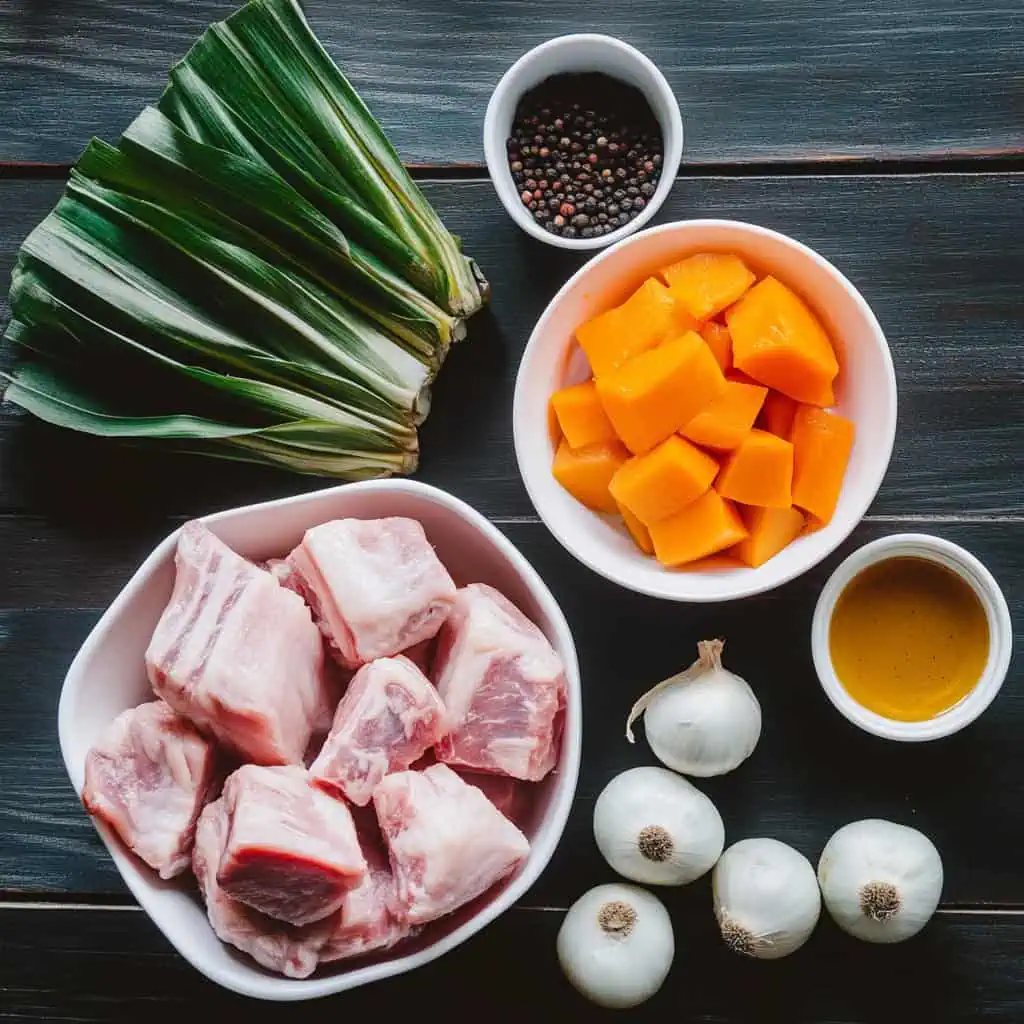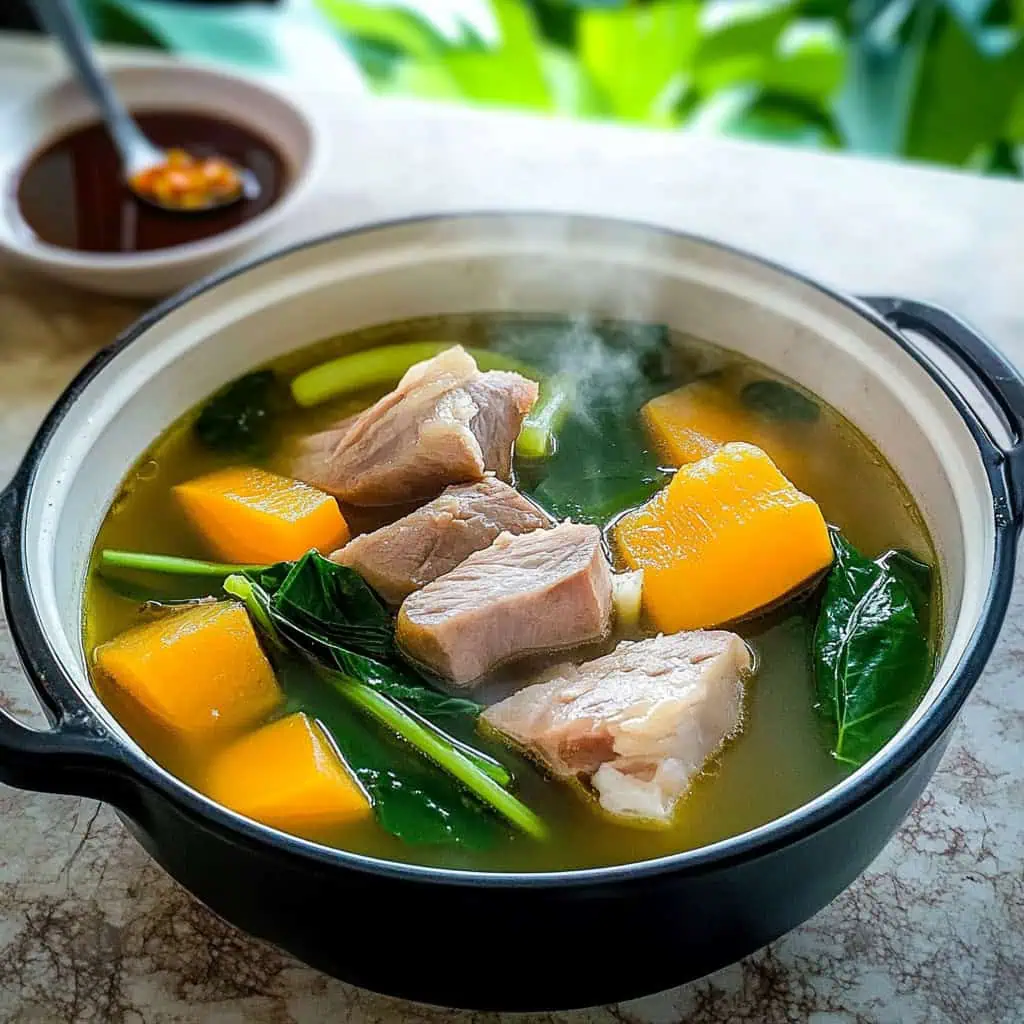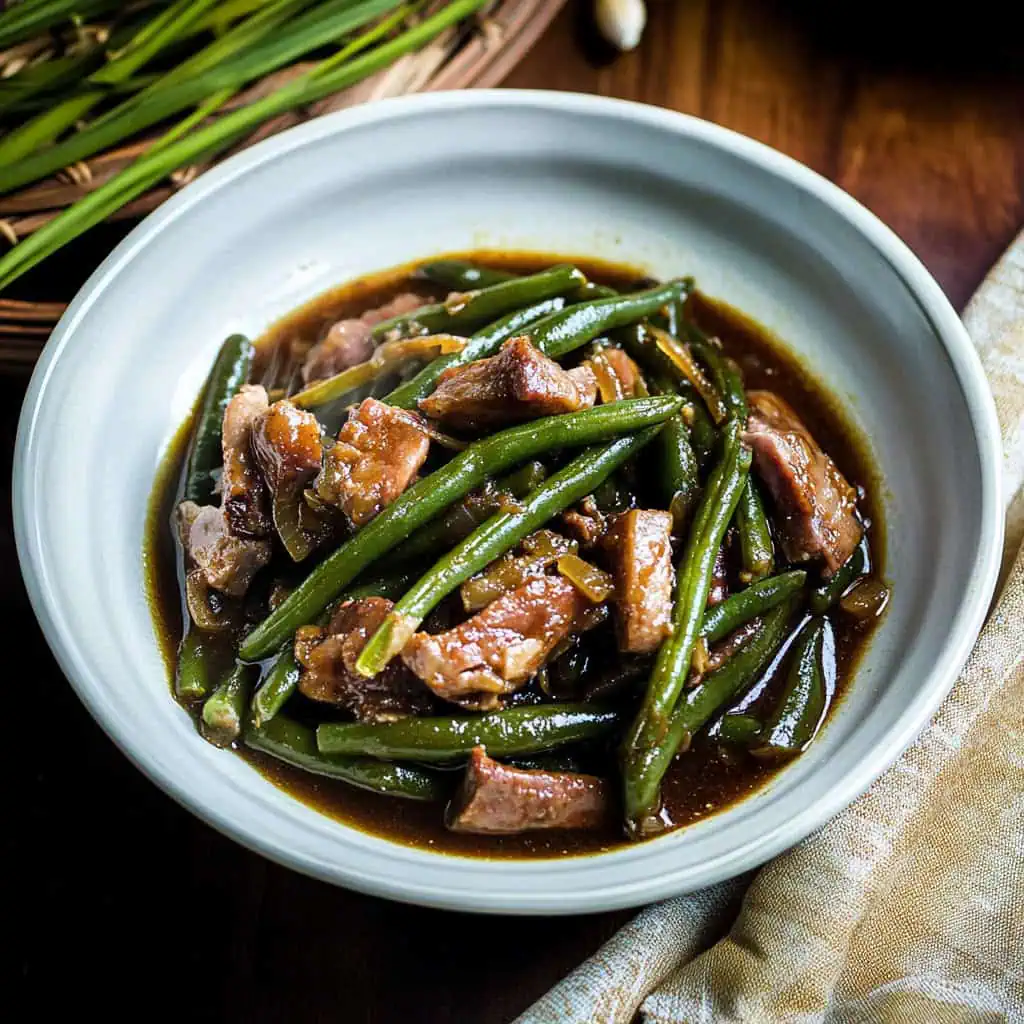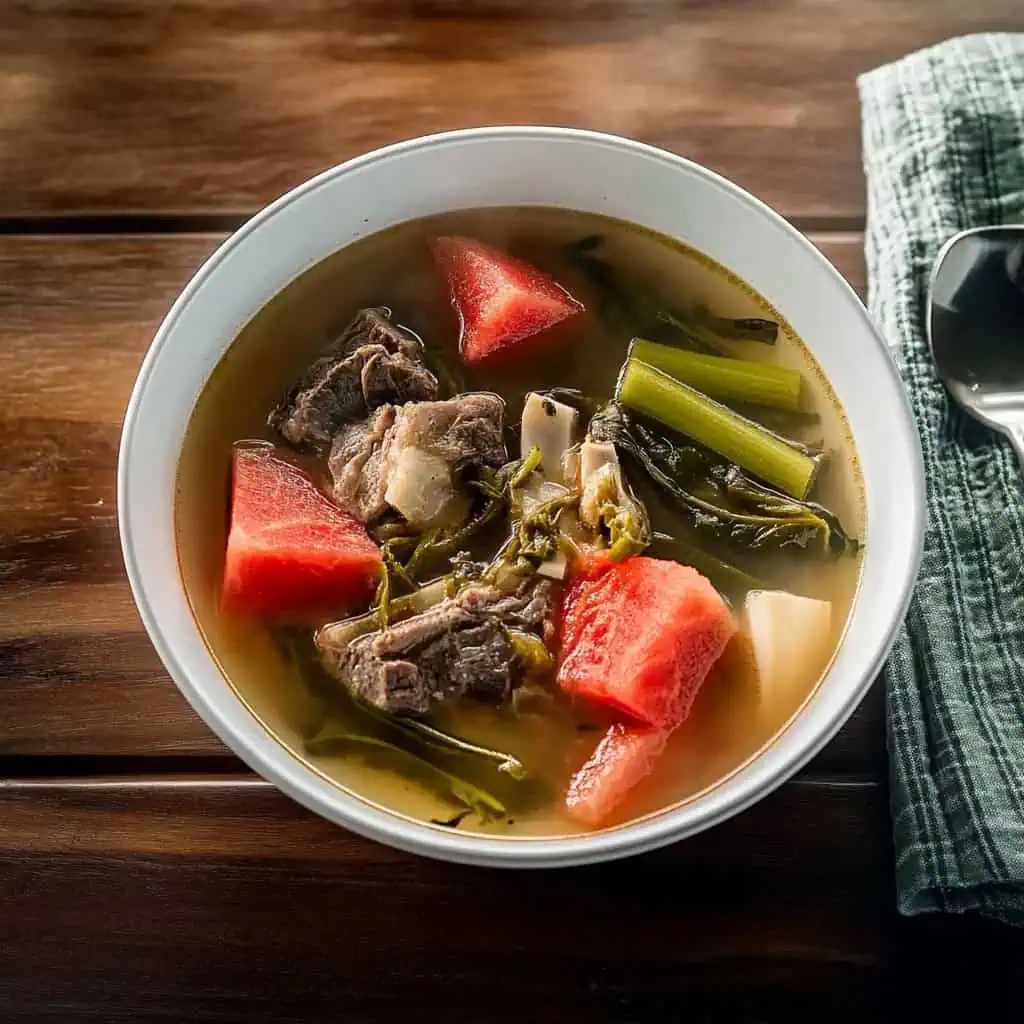A cornerstone of Filipino home cooking, Nilagang Baboy transforms humble ingredients into a soul-warming masterpiece.
This clear-broth soup stars fork-tender pork belly alongside sweet kalabasa and fresh pechay, creating a harmonious balance of flavors that has comforted generations of Filipino families.
While deceptively simple in preparation, the key to its excellence lies in the patient simmering of quality ingredients, allowing the natural sweetness of the pork and vegetables to enrich the broth.
Perfect for rainy days or whenever the craving for authentic Filipino comfort food strikes, this one-pot wonder delivers nourishment and nostalgia in every spoonful.
Cultural Notes
Nilagang Baboy is traditionally served as a family meal, especially during rainy season or cold weather. The word "Nilaga" means "boiled" in Filipino, while "Baboy" means pork. This dish represents the Filipino value of making delicious meals from simple ingredients and the importance of sharing food with family.
Jump to:

Why You'll Love This Recipe
- Simple, clean flavors that showcase the natural sweetness of pork and vegetables
- One-pot meal that's perfect for busy weeknights
- Budget-friendly comfort food that feeds a family
- Clear, step-by-step instructions perfect for beginners
- Versatile recipe that can be customized with seasonal vegetables
- Naturally gluten-free and dairy-free
Ingredients
This recipe blends traditional Filipino elements for the perfect balance of flavors and textures. Pork belly provides rich flavor and tender meat that becomes succulent after slow simmering.
Onion and peppercorns create a fragrant base for the broth, while fish sauce adds that distinctive savory depth Filipinos call "umami."
Kalabasa brings natural sweetness to balance the savory elements, and pechay adds fresh brightness and color, completing this perfectly balanced one-pot meal that has nourished Filipino families for generations.

- 2 pounds pork belly, cut into 2½ inch cubes
- 8 cups water
- 1 medium onion, peeled and quartered
- ½ teaspoon whole black peppercorns, cracked
- 1 tablespoon fish sauce
- Salt to taste
- 1 small calabasa/squash, peeled, seeded, cut into 2-inch chunks
- 2 bunches pechay (Chinese cabbage), ends trimmed and leaves separated
Equipment
- Large Heavy-Bottom Pot (Kaldero) - Ensures even heat distribution for perfectly tender meat
- Spider Strainer - Essential for skimming scum to achieve a clear, beautiful broth
- Sharp Knife - For cutting meat and vegetables uniformly for even cooking
- Cutting Board - Provides a stable, sanitary surface for food preparation
- Measuring Cups and Spoons - Ensures recipe accuracy for consistent results
- Ladle - For serving without disturbing the broth clarity
- Wooden Spoon - Allows gentle stirring without scratching your pot and maintains broth clarity

How To Make
- Start by cutting 2 pounds of pork belly into 2½-inch cubes. Peel and quarter one medium onion. Set these aside.
- Place the pork in a large pot and add 8 cups of cold water. Turn the heat to medium and bring to a boil. When bubbling, use a spoon to carefully remove any gray foam that rises to the top of the water.
- Once the water looks clear, add the quartered onion, ½ teaspoon cracked black peppercorns, and 1 tablespoon fish sauce. Let it boil for 1-2 minutes. Lower the heat, cover the pot, and cook for about 45 minutes until the pork is tender when pierced with a fork.
- While waiting, prepare your vegetables. Peel and remove seeds from one small squash (kalabasa), then cut it into 2-inch pieces. Wash two bunches of pechay and separate the leaves.
- When the pork is tender, add the squash pieces to the pot. Cook for about 6 minutes or until you can easily pierce them with a fork but they still hold their shape. Add the pechay leaves and cook for just one minute until they turn bright green but are still crisp.
- Taste the soup and add salt if needed. You can also add more fish sauce instead of salt if you prefer.
- Serve hot in bowls, with steamed rice on the side. For extra flavor, prepare a small dish of fish sauce mixed with chopped chilies as a dipping sauce for the meat.

Tips from Lola's Kitchen
For the Clearest Broth:
- Start with cold water - This helps extract flavors gradually and produces a cleaner taste
- Always skim diligently during the first boil - Those first 5 minutes of skimming make all the difference
- Maintain a gentle simmer, not a rolling boil - Aggressive boiling emulsifies fat into the broth, causing cloudiness
- Consider blanching the pork first - Boil for 5 minutes, discard that water, then start fresh for ultimate clarity
- Don't stir too frequently - Each stir can disturb the clarity of your broth
For the Most Tender Meat:
- Choose pork belly with good fat marbling - The fat renders slowly, keeping the meat moist
- Cut meat against the grain in uniform sizes for even cooking
- Don't rush the cooking process - Low and slow is the secret to melt-in-your-mouth texture
- Keep the simmer gentle and steady - Rapid boiling toughens meat proteins
- Let the meat rest in the hot broth for 10 minutes before serving for peak tenderness
For Perfect Vegetables:
- Add vegetables in stages based on their cooking times - This prevents mushiness
- Keep kalabasa chunks large (2-inches) so they don't disintegrate
- Add pechay only in the final minute - It continues cooking from residual heat
Substitutions
Pork Cuts:
- Pork shoulder (Kasim) - Less fatty but still flavorful, cook 15 minutes longer
- Pork leg (Pata) - More collagen for a richer broth, cook 30 minutes longer
- Spare ribs - Adds bone flavor to the broth, reduce amount to 2.5 pounds
Vegetables:
- Potatoes (Patatas) instead of kalabasa - Use waxy varieties that hold their shape
- Sweet potatoes (Kamote) instead of kalabasa - Adds natural sweetness
- Cabbage (Repolyo) instead of pechay - Chop into large pieces and add 3 minutes before serving
- Water spinach (Kangkong) instead of pechay - Add at the very end, just before turning off heat
Seasonings:
- Sea salt instead of fish sauce - Start with 1 teaspoon and adjust to taste
- Beef or chicken bouillon cube - Adds depth, use half a cube and reduce salt
- Fresh ginger (1-inch piece) - Adds warming note, excellent for cold weather
Troubleshooting
Cloudy Broth
- Problem: Gray, murky appearance instead of clear, golden broth
- Solutions:
- Blanch meat first: Boil for 5 minutes, discard water, rinse meat, then start fresh
- Skim more thoroughly during first 5-10 minutes of cooking
- Reduce heat to maintain gentle simmer only
- Avoid stirring too frequently
Tough Meat
- Problem: Pork remains chewy despite long cooking
- Solutions:
- Extend cooking time at low heat - some cuts may need up to 1.5 hours
- Ensure pieces are cut to uniform size for even cooking
- Check if heat is too high - reduce to gentle simmer
- Consider using a pressure cooker - 25 minutes on high pressure
Vegetables Too Soft
- Problem: Kalabasa or pechay falling apart or mushy
- Solutions:
- Add firmer vegetables (kalabasa) when meat is nearly tender, not too early
- Add leafy vegetables (pechay) only during final minute of cooking
- Cut vegetables into larger pieces to maintain structure
- Consider cooking vegetables separately and adding to individual serving bowls
Bland Flavor
- Problem: Broth lacks depth and savory notes
- Solutions:
- Increase fish sauce by 1-2 teaspoons
- Add 1 teaspoon of whole black peppercorns (not ground)
- Include 1-2 bay leaves during simmering
- Consider adding 1 small onion more, charred directly on flame first
Storage & Reheating
Refrigeration:
- Cool completely within 2 hours of cooking
- Store in airtight containers up to 3 days
- For best results, store broth and meat together, vegetables separately
Freezing:
- Freeze for up to 2 months in freezer-safe containers
- Leave 1-inch headspace for expansion
- Separate vegetables if possible before freezing
- For best texture, freeze broth and meat only, add fresh vegetables when reheating
Reheating:
- Stovetop: Warm over medium heat until hot (165°F/74°C), adding fresh vegetables during last few minutes
- Microwave: Heat in 2-minute intervals, stirring between each, until reaching 165°F/74°C
- If broth has thickened after storage, add ¼ cup water when reheating
- Add fresh herbs or a dash of fish sauce after reheating to brighten flavors

FAQ
Can I make this in a slow cooker?
Yes, this recipe works beautifully in a slow cooker. Cook on low for 6-8 hours or high for 4-6 hours. Add the kalabasa during the last hour and the pechay during the final 10 minutes for perfect texture.
Why is blanching the meat recommended?
Blanching serves three purposes: it removes impurities for a clearer broth, reduces excess fat creating a cleaner soup, and helps eliminate any strong pork odor, resulting in a more refined flavor profile.
Can I make this ahead for a party?
Yes, Nilagang Baboy actually improves in flavor overnight. Cook the meat and broth a day ahead, refrigerate, then skim any solidified fat from the surface before reheating. Add fresh vegetables just before serving for best texture and color.
How do I know when the pork is done?
The pork is perfectly cooked when it's fork-tender and easily pulls apart with minimal resistance. If you prefer to use a thermometer, the internal temperature should reach at least 145°F (63°C), though for this dish we cook well beyond that for tenderness.
Is this soup freezer-friendly?
Yes, the broth and meat freeze exceptionally well for up to 2 months. However, the vegetables will become mushy when frozen and reheated, so it's best to freeze only the broth and meat portion, then add fresh vegetables when reheating.
What's the best rice to serve with Nilagang Baboy?
Traditionally, plain steamed white rice is served alongside. Short-grain or medium-grain varieties that are slightly sticky work particularly well to absorb the flavorful broth.
How can I make this soup more filling?
Add starchy vegetables like potatoes, sweet potatoes, or corn on the cob. Some regions also add saba bananas (cooking plantains) which add delightful sweetness and make the dish more substantial.
What's the traditional way to eat Nilagang Baboy?
In Filipino homes, this is typically eaten by placing steamed rice in a bowl, ladling the soup and meat over it, and enjoying with a side dish of patis (fish sauce) mixed with calamansi juice or chopped chilies for dipping the meat.
Related
Looking for other recipes like this? Try these:

Nilagang Baboy (Filipino Pork Soup)
Equipment
- Large Heavy-Bottom Pot (Kaldero) Ensures even heat distribution for tender meat
- Spider strainer (sandok) For skimming scum to achieve a clear broth
- Sharp knife (kutsilyo) For cutting meat and vegetables uniformly
- Cutting board (Tabla) For safe food preparation
- Measuring cups and spoons (Panukat) For accurate ingredient portions
- Ladle - sandok For serving
- Wooden spoon (kutsarang kahoy) For gentle stirring without scratching the pot
Ingredients
For the Broth Base
- 2 pounds pork belly Liempo, cut into 2½ inch cubes
- 8 cups water Tubig
- 1 medium onion Sibuyas, peeled and quartered
- ½ teaspoon whole black peppercorns Paminta, cracked
- 1 tablespoon fish sauce Patis
- Salt Asin to taste
Vegetables
- 1 small calabasa/squash Kalabasa, peeled, seeded, cut into 2-inch chunks
- 2 bunches pechay Chinese cabbage, ends trimmed and leaves separated
Instructions
- Start by cutting 2 pounds of pork belly into 2½-inch cubes. Peel and quarter one medium onion. Set these aside.
- Place the pork in a large pot and add 8 cups of cold water. Turn the heat to medium and bring to a boil. When bubbling, use a spoon to carefully remove any gray foam that rises to the top of the water.
- Once the water looks clear, add the quartered onion, ½ teaspoon cracked black peppercorns, and 1 tablespoon fish sauce. Let it boil for 1-2 minutes. Lower the heat, cover the pot, and cook for about 45 minutes until the pork is tender when pierced with a fork.
- While waiting, prepare your vegetables. Peel and remove seeds from one small squash (kalabasa), then cut it into 2-inch pieces. Wash two bunches of pechay and separate the leaves.
- When the pork is tender, add the squash pieces to the pot. Cook for about 6 minutes or until you can easily pierce them with a fork but they still hold their shape. Add the pechay leaves and cook for just one minute until they turn bright green but are still crisp.
- Taste the soup and add salt if needed. You can also add more fish sauce instead of salt if you prefer.
- Serve hot in bowls, with steamed rice on the side. For extra flavor, prepare a small dish of fish sauce mixed with chopped chilies as a dipping sauce for the meat.
- The soup should be enjoyed while hot, with clear broth and tender meat that easily pulls apart with your spoon.
- Tip: To make sure your soup stays clear, avoid stirring it too much and always remove foam that rises to the top during the first boil.*
Tips from Lola's Kitchen
- For the clearest broth:
- Start with cold water
- Skim diligently during the first boil
- Maintain a gentle simmer, not a rolling boil
- Consider blanching the pork first
- For the most tender meat:
- Choose pork belly with good fat marbling
- Cut meat against the grain
- Don't rush the cooking process
- Keep the simmer gentle and steady
Nutrition
The Story Behind Nilagang Baboy
Growing up in every Filipino household, Nilagang Baboy stands as a testament to the resourceful and nurturing spirit of our ancestors. This humble yet hearty soup, whose name directly translates to "boiled pork," emerged from the practical need to create sustaining meals that could feed large families with simple, accessible ingredients. While its exact origins are woven into the fabric of pre-colonial Philippine cooking traditions, the technique of slow-boiling meat to create a nourishing broth has been passed down through generations of Filipino families.
In the northern regions of the Philippines, particularly during the cold months of habagat (monsoon season), Nilagang Baboy became a staple comfort food. The slow-simmering process not only made tough cuts of meat tender but also created a warming broth that could chase away the chill of rainy evenings. What began as a practical cooking method evolved into an art form, with each region and family developing their own signature combinations of vegetables and preferred cuts of pork.
The genius of Nilagang Baboy lies in its celebration of simplicity. Unlike its cousin Sinigang, which features a sour broth, or the rich, peanut-based Kare-Kare, Nilaga relies purely on the natural flavors of its ingredients. The slow-cooked pork releases its essence into the broth, while vegetables like kalabasa (native squash) add a subtle sweetness that perfectly balances the savory depth. This natural approach to flavor building reflects the Filipino culinary philosophy of letting quality ingredients speak for themselves.
Today, Nilagang Baboy remains a beloved fixture in both humble kitchens and upscale Filipino restaurants. Its enduring popularity spans generations, from elderly lolas (grandmothers) who insist on their time-tested methods to modern home cooks discovering the comforting powers of this classic soup. Whether served during family Sunday lunches, rainy afternoons, or as a remedy for the common cold, this dish continues to tell the story of Filipino cuisine - one that values simplicity, community, and the healing power of a well-made soup.
Modern interpretations might vary in their choice of vegetables or cuts of pork, but the essence remains unchanged: a clear, flavorful broth, tender meat, and the fresh brightness of vegetables, all coming together to create what many consider the ultimate Filipino comfort food. In an era of complex culinary trends, Nilagang Baboy stands as a reminder that sometimes, the most satisfying dishes are the ones that have been simmering on our stoves, and in our culture, for generations.










Comments
No Comments